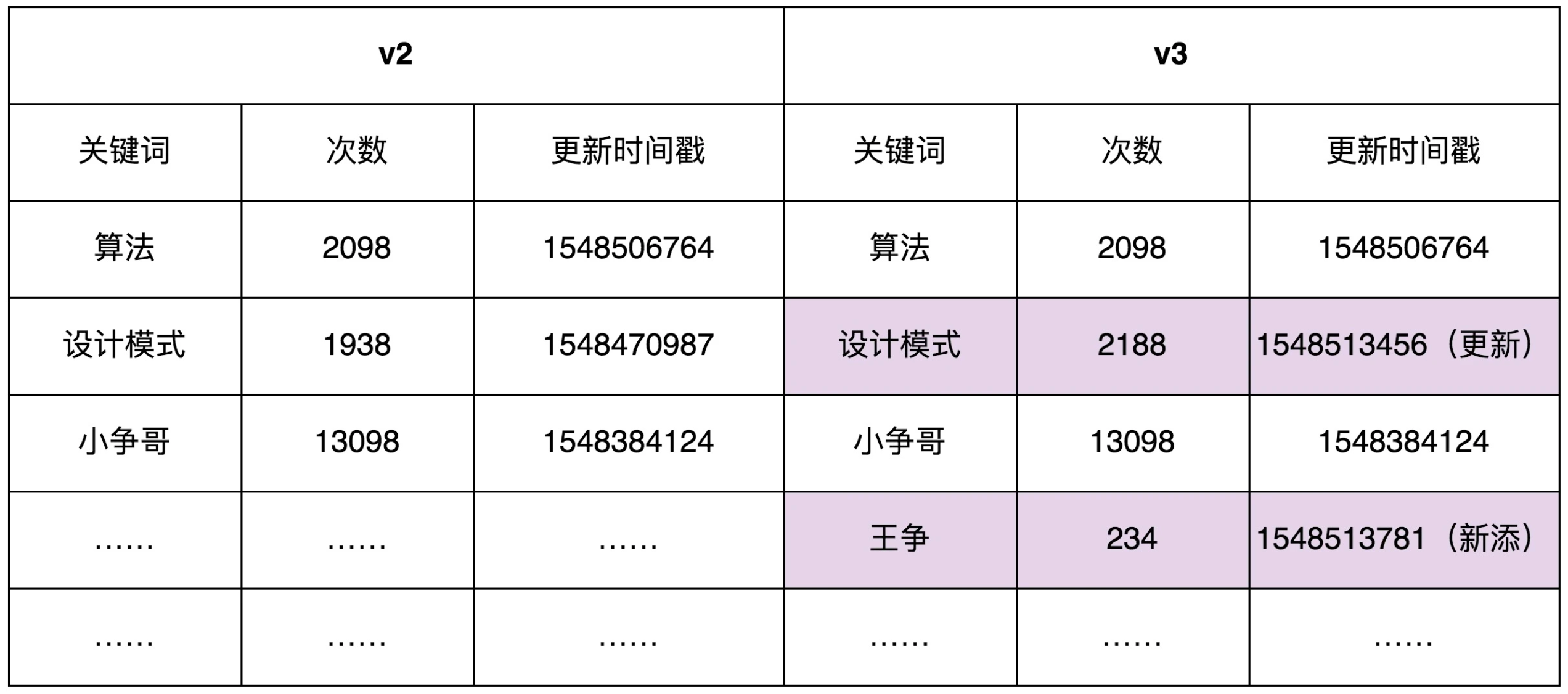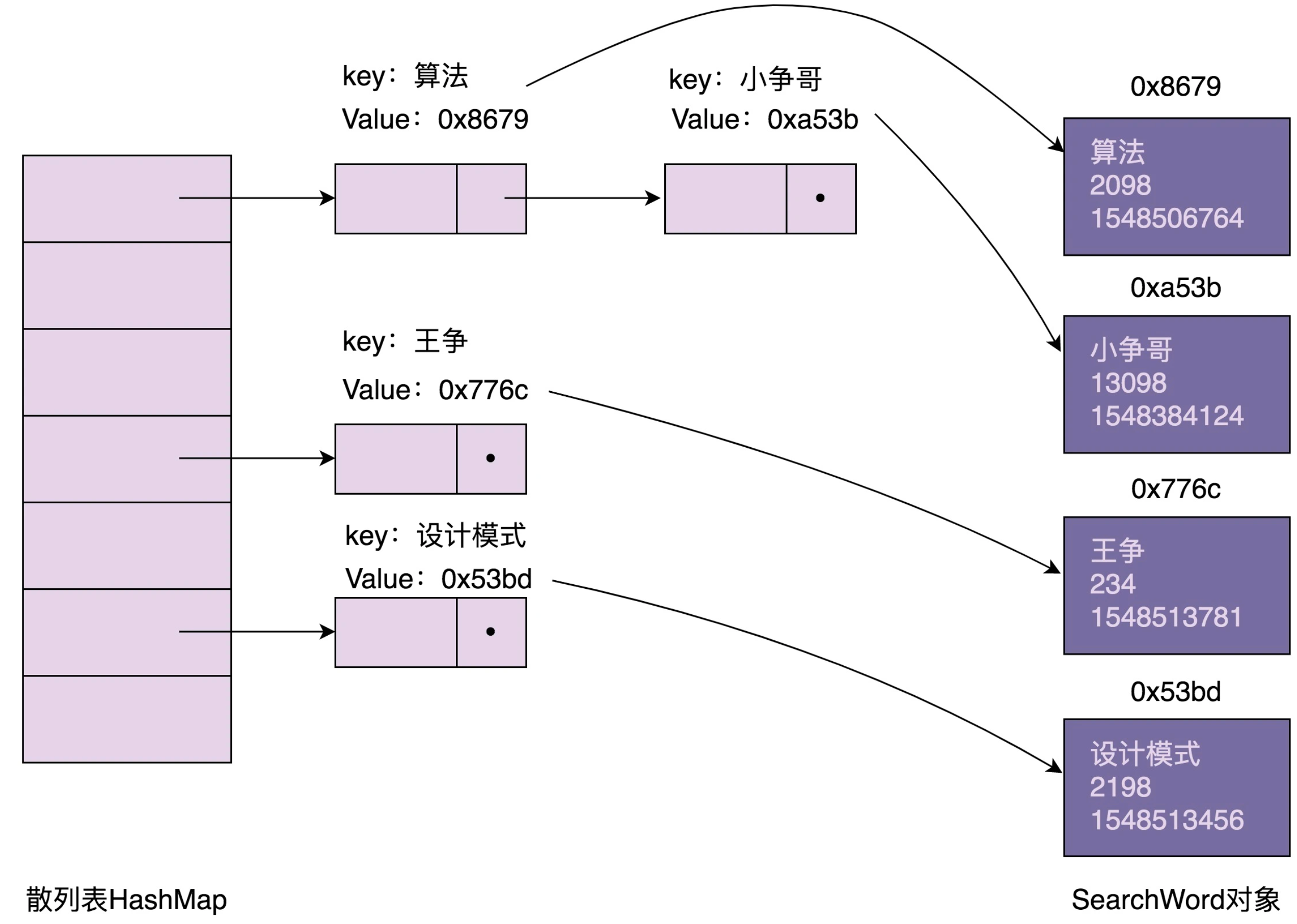原型模式
如果对象的创建成本比较大,而同一个类的不同对象之间差别不大(大部分字段都相同),在这种情况下,我们可以利用对已有对象(原型)进行复制(或者叫拷贝)的方式来创建新对象,以达到节省创建时间的目的。这种基于原型来创建对象的方式就叫作原型设计模式(Prototype Design Pattern),简称原型模式。
什么情况下创建对象的成本比较大呢?
一般创建对象包含的申请内存、给成员变量赋值这一过程,本身并不会花费太多时间,但是如果对象中的数据需要经过复杂的计算才能得到(比如排序、计算哈希值),或者需要从 RPC、网络、数据库、文件系统等非常慢速的 IO 中读取,这种情况下,就可以利用原型模式,从其他已有对象中直接拷贝得到,而不用每次在创建新对象的时候,都重复执行这些耗时的操作。
问题1
下面来看一个例子:
假设数据库中存储了大约 10 万条“搜索关键词”信息,每条信息包含关键词、关键词被搜索的次数、信息最近被更新的时间等。系统 A 在启动的时候会加载这份数据到内存中,用于处理某些其他的业务需求。为了方便快速地查找某个关键词对应的信息,给关键词建立一个散列表索引。
关于这个问题,可以直接使用 HashMap 容器来实现。其中,HashMap 的 key 为搜索关键词,value 为关键词详细信息(比如搜索次数)。只需要将数据从数据库中读取出来,放入 HashMap 就可以了。不过,我们还有另外一个系统 B,专门用来分析搜索日志,定期(比如间隔 10 分钟)批量地更新数据库中的数据,并且标记为新的数据版本。比如,在下面的示例图中,对 v2 版本的数据进行更新,得到 v3 版本的数据。假设只有更新和新添关键词,没有删除关键词的行为。

为了保证系统 A 中数据的实时性(不一定非常实时,但数据也不能太旧),系统 A 需要定期根据数据库中的数据,更新内存中的索引和数据。
该如何实现这个需求呢?
实际上,只需要在系统 A 中,记录当前数据的版本 Va 对应的更新时间 Ta,从数据库中捞出更新时间大于 Ta 的所有搜索关键词,也就是找出 Va 版本与最新版本数据的“差集”,然后针对差集中的每个关键词进行处理。如果它已经在散列表中存在了,我们就更新相应的搜索次数、更新时间等信息;如果它在散列表中不存在,就将它插入到散列表中。按照这个设计思路,示例代码如下所示:
public class Demo { private ConcurrentHashMap<String, SearchWord> currentKeywords = new ConcurrentHashMap<>(); private long lastUpdateTime = -1; public void refresh() { // 从数据库中取出更新时间>lastUpdateTime的数据,放入到currentKeywords中 List<SearchWord> toBeUpdatedSearchWords = getSearchWords(lastUpdateTime); long maxNewUpdatedTime = lastUpdateTime; for (SearchWord searchWord : toBeUpdatedSearchWords) { if (searchWord.getLastUpdateTime() > maxNewUpdatedTime) { maxNewUpdatedTime = searchWord.getLastUpdateTime(); } if (currentKeywords.containsKey(searchWord.getKeyword())) { currentKeywords.replace(searchWord.getKeyword(), searchWord); } else { currentKeywords.put(searchWord.getKeyword(), searchWord); } } lastUpdateTime = maxNewUpdatedTime; } private List<SearchWord> getSearchWords(long lastUpdateTime) { // TODO: 从数据库中取出更新时间>lastUpdateTime的数据 return null; } }
问题2
现在,针对问题1再增加一个新的需求:任何时刻,系统 A 中的所有数据都必须是同一个版本的,要么都是版本 a,要么都是版本 b,不能有的是版本 a,有的是版本 b。那刚刚的更新方式就不能满足这个要求了。除此之外,还要求:在更新内存数据的时候,系统 A 不能处于不可用状态,也就是不能停机更新数据。
该如何实现现在这个需求呢?
实际上,也不难。我们把正在使用的数据的版本定义为“服务版本”,当我们要更新内存中的数据的时候,我们并不是直接在服务版本(假设是版本 a 数据)上更新,而是重新创建另一个版本数据(假设是版本 b 数据),等新的版本数据建好之后,再一次性地将服务版本从版本 a 切换到版本 b。这样既保证了数据一直可用,又避免了中间状态的存在。按照这个设计思路,示例代码如下所示:
public class Demo { private HashMap<String, SearchWord> currentKeywords=new HashMap<>(); public void refresh() { HashMap<String, SearchWord> newKeywords = new LinkedHashMap<>(); // 从数据库中取出所有的数据,放入到newKeywords中 List<SearchWord> toBeUpdatedSearchWords = getSearchWords(); for (SearchWord searchWord : toBeUpdatedSearchWords) { newKeywords.put(searchWord.getKeyword(), searchWord); } currentKeywords = newKeywords; } private List<SearchWord> getSearchWords() { // TODO: 从数据库中取出所有的数据 return null; } }
问题3
在问题2的代码实现中,newKeywords 构建的成本比较高。需要将这 10 万条数据从数据库中读出,然后计算哈希值,构建 newKeywords。这个过程显然是比较耗时。为了提高效率,原型模式就派上用场了。
我们拷贝 currentKeywords 数据到 newKeywords 中,然后从数据库中只捞出新增或者有更新的关键词,更新到 newKeywords 中。而相对于 10 万条数据来说,每次新增或者更新的关键词个数是比较少的,所以,这种策略大大提高了数据更新的效率。按照这个设计思路,示例代码如下所示:
public class Demo { private HashMap<String, SearchWord> currentKeywords=new HashMap<>(); private long lastUpdateTime = -1; public void refresh() { // 原型模式就这么简单,拷贝已有对象的数据,更新少量差值 HashMap<String, SearchWord> newKeywords = (HashMap<String, SearchWord>) currentKeywords.clone(); // 从数据库中取出更新时间>lastUpdateTime的数据,放入到newKeywords中 List<SearchWord> toBeUpdatedSearchWords = getSearchWords(lastUpdateTime); long maxNewUpdatedTime = lastUpdateTime; for (SearchWord searchWord : toBeUpdatedSearchWords) { if (searchWord.getLastUpdateTime() > maxNewUpdatedTime) { maxNewUpdatedTime = searchWord.getLastUpdateTime(); } if (newKeywords.containsKey(searchWord.getKeyword())) { SearchWord oldSearchWord = newKeywords.get(searchWord.getKeyword()); oldSearchWord.setCount(searchWord.getCount()); oldSearchWord.setLastUpdateTime(searchWord.getLastUpdateTime()); } else { newKeywords.put(searchWord.getKeyword(), searchWord); } } lastUpdateTime = maxNewUpdatedTime; currentKeywords = newKeywords; } private List<SearchWord> getSearchWords(long lastUpdateTime) { // TODO: 从数据库中取出更新时间>lastUpdateTime的数据 return null; } }
其实上面的代码也存在问题,这就涉及到原型模式的实现方式了。
2、原型模式的实现方式:深拷贝和浅拷贝
在内存中,用散列表组织的搜索关键词信息是如何存储的。大致结构如下所示。从图中可以发现,散列表索引中,每个结点存储的 key 是搜索关键词,value 是 SearchWord 对象的内存地址。SearchWord 对象本身存储在散列表之外的内存空间中。

浅拷贝和深拷贝的区别在于,浅拷贝只会复制图中的索引(散列表),不会复制数据(SearchWord 对象)本身。相反,深拷贝不仅仅会复制索引,还会复制数据本身。浅拷贝得到的对象(newKeywords)跟原始对象(currentKeywords)共享数据(SearchWord 对象),而深拷贝得到的是一份完完全全独立的对象。具体的对比如下图所示:

Java 中 Object 类的 clone() 方法执行的就是我们刚刚说的浅拷贝。它只会拷贝对象中的基本数据类型的数据(比如,int、long),以及引用对象(SearchWord)的内存地址,不会递归地拷贝引用对象本身。
在问题3的代码中,通过调用 HashMap 上的 clone() 浅拷贝方法来实现原型模式。当通过 newKeywords 更新 SearchWord 对象的时候(比如,更新“设计模式”这个搜索关键词的访问次数),newKeywords 和 currentKeywords 因为指向相同的一组 SearchWord 对象,就会导致 currentKeywords 中指向的 SearchWord,有的是老版本的,有的是新版本的,就没法满足之前的需求:currentKeywords 中的数据在任何时刻都是同一个版本的,不存在介于老版本与新版本之间的中间状态。
又该如何来解决这个问题呢?
可以将浅拷贝替换为深拷贝。newKeywords 不仅仅复制 currentKeywords 的索引,还把 SearchWord 对象也复制一份出来,这样 newKeywords 和 currentKeywords 就指向不同的 SearchWord 对象,也就不存在更新 newKeywords 的数据会导致 currentKeywords 的数据也被更新的问题了。
实现深拷贝有两种方法:
第一种是递归:递归拷贝对象、对象的引用对象以及引用对象的引用对象……直到要拷贝的对象只包含基本数据类型数据,没有引用对象为止。根据这个思路对之前的代码进行重构。重构之后的代码如下所示:
public class Demo { private HashMap<String, SearchWord> currentKeywords=new HashMap<>(); private long lastUpdateTime = -1; public void refresh() { // Deep copy HashMap<String, SearchWord> newKeywords = new HashMap<>(); for (HashMap.Entry<String, SearchWord> e : currentKeywords.entrySet()) { SearchWord searchWord = e.getValue(); SearchWord newSearchWord = new SearchWord( searchWord.getKeyword(), searchWord.getCount(), searchWord.getLastUpdateTime()); newKeywords.put(e.getKey(), newSearchWord); } // 从数据库中取出更新时间>lastUpdateTime的数据,放入到newKeywords中 List<SearchWord> toBeUpdatedSearchWords = getSearchWords(lastUpdateTime); long maxNewUpdatedTime = lastUpdateTime; for (SearchWord searchWord : toBeUpdatedSearchWords) { if (searchWord.getLastUpdateTime() > maxNewUpdatedTime) { maxNewUpdatedTime = searchWord.getLastUpdateTime(); } if (newKeywords.containsKey(searchWord.getKeyword())) { SearchWord oldSearchWord = newKeywords.get(searchWord.getKeyword()); oldSearchWord.setCount(searchWord.getCount()); oldSearchWord.setLastUpdateTime(searchWord.getLastUpdateTime()); } else { newKeywords.put(searchWord.getKeyword(), searchWord); } } lastUpdateTime = maxNewUpdatedTime; currentKeywords = newKeywords; } private List<SearchWord> getSearchWords(long lastUpdateTime) { // TODO: 从数据库中取出更新时间>lastUpdateTime的数据 return null; } }
第二种是序列化:先将对象序列化,然后再反序列化成新的对象。具体的示例代码如下所示:
public Object deepCopy(Object object) { ByteArrayOutputStream bo = new ByteArrayOutputStream(); ObjectOutputStream oo = new ObjectOutputStream(bo); oo.writeObject(object); ByteArrayInputStream bi = new ByteArrayInputStream(bo.toByteArray()); ObjectInputStream oi = new ObjectInputStream(bi); return oi.readObject(); }
上面两种实现方法,深拷贝都要比浅拷贝耗时、耗内存空间。针对这个应用场景,有没有更快、更省内存的实现方式呢?
可以先采用浅拷贝的方式创建 newKeywords。对于需要更新的 SearchWord 对象,我们再使用深度拷贝的方式创建一份新的对象,替换 newKeywords 中的老对象。毕竟需要更新的数据是很少的。这种方式即利用了浅拷贝节省时间、空间的优点,又能保证 currentKeywords 中的数据都是老版本的数据。具体的代码实现如下所示:
public class Demo { private HashMap<String, SearchWord> currentKeywords=new HashMap<>(); private long lastUpdateTime = -1; public void refresh() { // Shallow copy HashMap<String, SearchWord> newKeywords = (HashMap<String, SearchWord>) currentKeywords.clone(); // 从数据库中取出更新时间>lastUpdateTime的数据,放入到newKeywords中 List<SearchWord> toBeUpdatedSearchWords = getSearchWords(lastUpdateTime); long maxNewUpdatedTime = lastUpdateTime; for (SearchWord searchWord : toBeUpdatedSearchWords) { if (searchWord.getLastUpdateTime() > maxNewUpdatedTime) { maxNewUpdatedTime = searchWord.getLastUpdateTime(); } if (newKeywords.containsKey(searchWord.getKeyword())) { newKeywords.remove(searchWord.getKeyword()); } newKeywords.put(searchWord.getKeyword(), searchWord); } lastUpdateTime = maxNewUpdatedTime; currentKeywords = newKeywords; } private List<SearchWord> getSearchWords(long lastUpdateTime) { // TODO: 从数据库中取出更新时间>lastUpdateTime的数据 return null; } }




 浙公网安备 33010602011771号
浙公网安备 33010602011771号